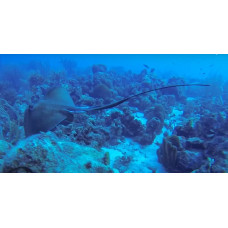Latin name
Dasyatis sabina
Identification
The Atlantic stingray has an elongated, pointed snout. Spiracles are located behind the eyes. The ventral surface of the disc has five pairs of gill slits, a mouth, and oval nostrils. Between the nostrils is a flap of skin with a fringed lower edge. The mouth is curved into an arc shape, and three thick processes are located at the bottom of the oral cavity. The teeth are arranged in a checkerboard pattern, forming a flat surface. Usually blunt, the teeth of adult males become pointed during the breeding season, allowing them to grab females by the edges of their fins. Like other stingrays, there is a serrated thorn on the dorsal surface of the tail stem, connected by ducts to a poisonous gland. Sometimes stingrays have two thorns. Every year, between June and October, the thorn breaks off and a new one grows in its place. The thorn is 1/4 the width of the disc. Ventral and dorsal skin folds are located behind the thorn on the caudal peduncle. In large individuals, a row of plaques or spines runs from the spine to the base of the tail. Large females have plaques around their eyes and spiracle.
Dasyatis sabina inhabits freshwater and has a blood concentration of urea and other osmolytes that is only 30–50% of what is typical for marine populations of this species. However, the difference in concentration between their blood and the surrounding water can cause water to diffuse into their bodies. To compensate for this effect, they must produce large amounts of diluted urine (10 times more than individuals living in seawater).
Features of fish fins
The pectoral fins of the Atlantic stingray are fused to the head, forming a diamond-shaped flat disc, the width of which is equal to 1.1 times its length, with rounded fins (“wings”) and a curved front edge. The tail is long and whip-like.
Fish colouring
The dorsal surface of the disc is yellowish-brown. The edges of the disc are lighter than the background color, and there is a dark stripe running along the spine. The underside of the disc is white or gray. The tail skin folds are yellowish. In large individuals, the tail is sometimes covered with spots, and the base turns gray while the tip darkens.
Distribution
They are widespread in the western Atlantic, from Chesapeake Bay to Florida and the Gulf of Mexico, including the waters off the coast of Campeche. However, reports of their presence off the coasts of Grenada, Suriname, and Brazil are questionable and may refer to other species of stingray. These rays can live in water with a wide range of salinity levels. They enter freshwater rivers such as the Mississippi and the St. Johns and inhabit Lake Pontchartrain. The Atlantic stingrays in Lake Pontchartrain are the only permanent population of elasmobranchii fish in North America's freshwater.
Habitat
Subtropical demersal species. They are found in shallow coastal waters on sandy or silty bottoms at depths ranging from 2 to 25 meters, usually between 2 and 6 meters. They prefer water temperatures above 15°C and can tolerate temperatures over 30°C. Despite their constant presence in freshwater, these rays are euryhaline.
Size
Its maximum recorded length is 61 cm, and its maximum recorded weight is 4.9 kg.
Behavior
They migrate seasonally, staying in warm waters during the winter. They only come to the Chesapeake Bay in the summer and fall. In other areas, they descend to greater depths in the winter. They remain at depths of 2–6 meters near the shore and descend to 25 meters during migration.
Food and feeding habits
Atlantic stingrays are bottom-feeders that hunt invertebrates such as bivalves, tube-dwelling anemones, amphipods, and nereids. They locate their prey using electroreception. Their diet varies depending on their habitat. While hunting, they turn their snouts against the current to wash away the sediment layer.
Reproduction
Like other stingrays, the Dasyatis sabina is an ovoviviparous fish. In Florida, both the marine and freshwater populations reproduce annually from September to October and from March to April. Ovulation occurs no earlier than March or early April. During mating, the male follows the female and grabs her by the edge of her fin with his teeth. Then, mating occurs. The embryos develop in the mother's womb and feed on yolk and histotroph. The litter consists of one to four newborns, each 10–13 cm long, born in late July and early August. Pregnancy lasts four to four and a half months. Marine males and females reach sexual maturity at disc widths of about 20 and 24 cm, respectively. For the freshwater population, this figure is 21 cm and 22 cm, respectively.
Fishing
The Dasyatis sabina is not a target species for fishing. However, off the coast of North Carolina, it is caught as bycatch in commercial flounder fisheries that use gillnets. The stingrays are usually released back into the sea alive.
Relationship with a person
Stepping on an Atlantic stingray can result in a painful sting from its venomous barb. Freshwater populations may suffer from deteriorating habitat conditions. The International Union for Conservation of Nature has given this species a "Least Concern" conservation status.
| Classification | |
| Phylum | Chordata |
| Class | Chondrichthyes |
| Squad | Myliobatiformes |
| Family | Dasyatidae |
| Genus | Hypanus |
| Species | H. sabinus |
| Features | |
| Conservation status | Least Concern |
| Habitat | Bottom |
| Life span, years | No information |
| Maximum body weight, kg | 4,9 |
| Maximum length, cm | 61 |
| Sailing speed, m/s | No information |
| Threat to people | Edible |
| Way of eating | Bentophage |
Atlantic stingray
Tags: atlantic stingray



